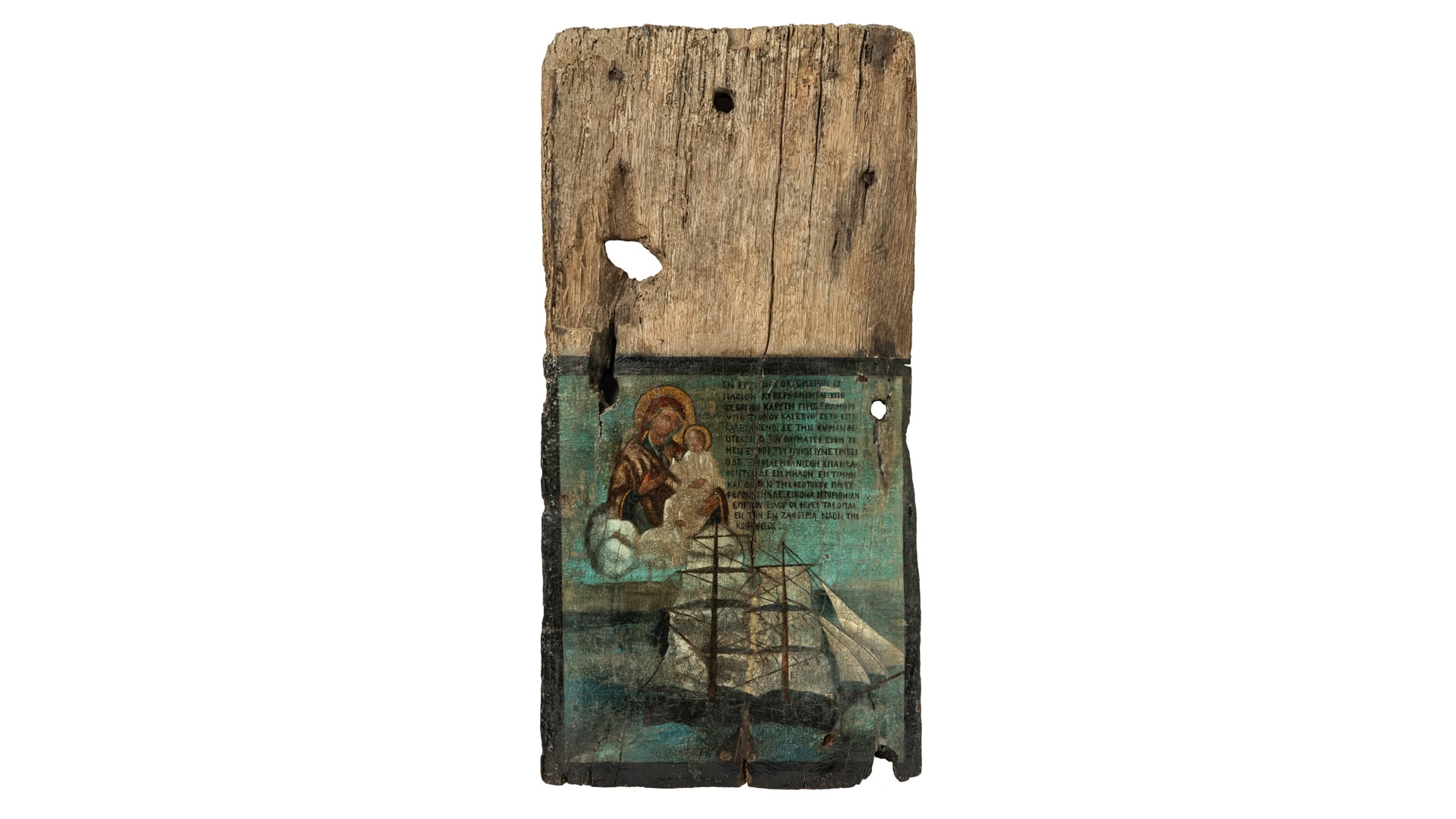The Virgin Mary rescues a ship

According to its inscription, the icon, which dates after October 17th, 1576 (?), was dedicated to the church of the Dormition of the Theotokos at Zephyria on Melos, evidently as a token of gratitude to the Virgin Mary for having intervened and rescued a ship that was in danger of sinking, following an attack by a swordfish. The dedicatory inscription also reveals the exact day on which the incident took place, as well as the captain’s name (Georgios Karoutis). The phrase ἐπανελθόντες δὲ εἰς Μῆλον… προσέφερον τήνδε εἰκόνα (upon our return to Melos … we offered this icon) suggests that the ship had set sail from the harbour of Melos and that the crew members, upon their return, dedicated the icon painted on the wooden part of the ship where the swordfish had left the traces of its attack.
This icon belongs to the category of the ex-voto objects. These objects, which are often icons, originate in life-threatening situations that the faithful had experienced, from which they were eventually saved. Having attributed the happy outcome of their ordeal to their appeal for assistance to specific saints, many worshippers later offered votive icons to churches dedicated to these saints in order to express their gratitude.
ΕΝ ΕΤΕΙ 18ׅ9ׅ6 ΟΚΤΩΜΒΡΙΟΥ 17 ΠΛΟΙΟΝ ΚΥΒΕΡΝΟΜΕΝΟΝ ΥΠΟ ΓΕΩΡΓΙΟΥ ΚΑΡΟΥΤΗ ΠΡΟΣΕΒΛΗΘΗ ΥΠΟ ΞΗΦΙΟΥ ΚΑΙ ΕΒΥΘΙΖΕΤΟ ΕΠΙΚΑΛΕΣΑΜΕΝΟΙ ΔΕ ΤΗΝ ΚΥΡΙΑΝ ΘΕΟΤΟΚΟΝ Ω ΤΟΥ ΘΑΥΜΑΤΟΣ ΕΥΘΥΣ ΤΟ ΜΕΝ ΞΗΦΟΣ ΤΟΥ ΙΧΘΥΟΣ ΣΥΝΕΤΡΙΒΕΙ Ο ΔΕ ΞΗΦΙΑΣ ΗΦΑΝΙΣΘΗ ΕΠΑΝΕΛΘΟΝΤΕΣ ΔΕ ΕΙΣ ΜΗΛΟΝ ΕΙΣ ΤΙΜΗΝ 10 ΚΑΙ ΔΟΞΑΝ ΤΗΣ ΘΕΟΤΟΚΟΥ ΠΡΟΣΕΦΕΡΟΝ ΤΗΝΔΕ ΕΙΚΟΝΑ ΙΣΤΟΡΗΘΗΣΑΝ ΕΠΙ ΤΟΥ ΞΥΛΟΥ ΟΥ ΦΕΡΕΙ ΤΑΣ ΟΠΑΣ ΕΙΣ ΤΟΝ ΕΝ ΖΑΦΕΙΡΙΑ ΝΑΟΝ ΤΗΣ ΚΟΙΜΗΣΕΩΣ
Ἐν ἒτει 18ׅ9ׅ6 Ὀκτωβρίου 17,πλοῖον κυβερνώμενον ὑπὸ Γεωργίου Καρούτη προσεβλήθη ὑπὸ ξιφίου καὶ ἐβυθίζετο˙ ἐπικαλεσάμενοι δὲ τὴν κυρίαν Θεοτόκον, ὢ τοῦ θαύματος, εὐθὺς τὸ μὲν ξίφος τοῦ ἰχθύος συνετρίβη, ὁ δὲ ξιφίας ἠφανίσθη˙ ἐπανελθόντες δὲ εἰς Μῆλον εἰς τιμὴν καὶ δόξαν τῆς Θεοτόκου, προσέφερον τήνδε εἰκόνα ἱστορηθεῖσαν ἐπι τοῦ ξύλου, ὃ φέρει τὰς ὀπάς, εἰς τὸν ἐν Ζεφυρίᾳ ναὸν τῆς Κοιμήσεως.